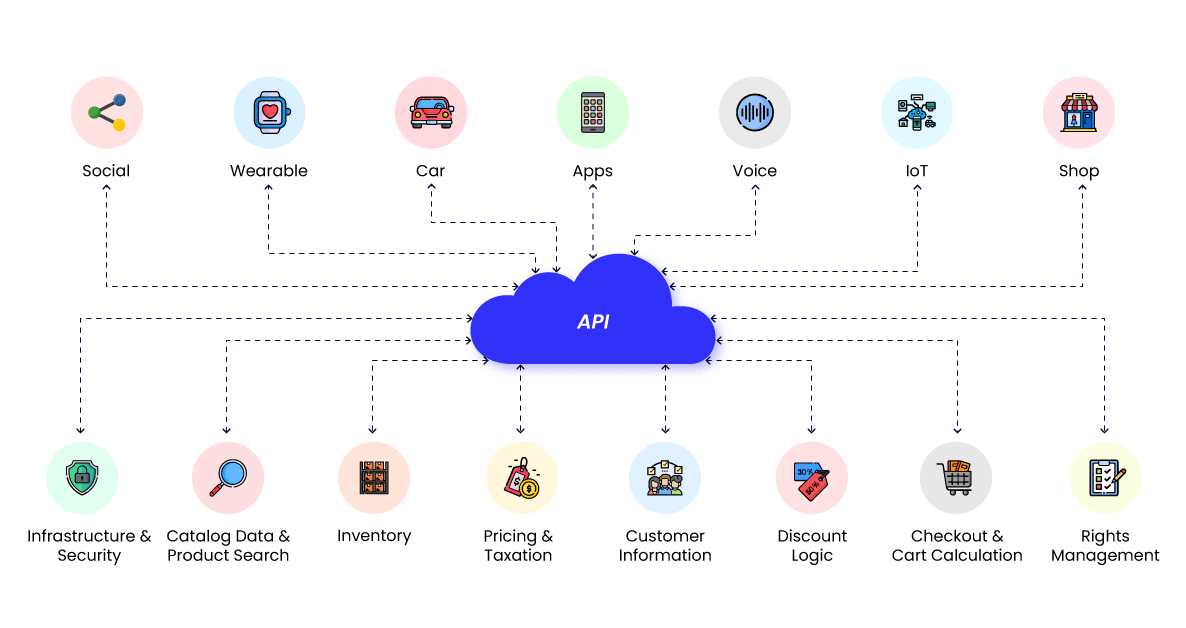
Subscribe to our Blog
We're committed to your privacy. SayOne uses the information you provide to us to contact you about our relevant content, products, and services. check out our privacy policy.

Real PradFebruary 14, 20226 min read

Generating table of contents...
Digital commerce is on a boom today. The pandemic has accelerated eCommerce growth in most countries and this is expected to only increase. Ecommerce sales are expected to reach 19.2% of all US retail spending by 2024. This indicates that customers increasingly prefer to shop online.
Global corporations that hit hurdles in terms of scalability, speed, and agility first resorted to using microservices. Amazon, the online commerce provider, was one of the earliest among them. The earliest version of microservices in Amazon was constructed to shorten the development pipeline. However, this approach revolutionized their application software and other eCommerce companies soon jumped into the microservices bandwagon. Today eCommerce microservices architecture is helping to build and run online stores along with the surrounding digital experiences.
In the following paragraphs, we attempt to have a peek into microservices help to power modern eCommerce stores and satisfy rising customer expectations.
Microservices architecture constitutes a set of modular services that are loosely coupled and which communicate via APIs. Each of these services can be designed, developed, deployed, and maintained by independent teams. Other advantages are:

Microservices is proving to be the ultimate way to prepare eCommerce platforms for traffic peaks, and implement and test out the latest trends, such as new touch-points, new payment methods, PWAs, and voice assistants, without significant risks. Many eCommerce giants have introduced microservices to get over typical eCommerce challenges, like traffic peaks during holiday seasons and festival discounts.
Newly introduced eCommerce solutions are built with the headless approach and these fit perfectly with systems that are built using a microservices architecture.
Read our blog “Why eCommerce Microservices and Headless Are the Future of Online Retail”.
Microservices allow the setting up of complex omnichannel systems. To help your customers derive the full benefits of omnichannel commerce and satisfy their expectations (which are running sky-high), you would have to all the information about products, stock, shipments, and orders up to date always. Microservices also enable to successfully use of API gateways to integrate and synchronize ERP, POS, or WMS best-in-category solutions with existing processes.
The latest eCommerce solutions make use of modular API-based solutions. These help to decouple the components in the tech stack, remove unnecessary code, and prevent the different services to become vendor-specific.
Do you want to learn more about microservices architecture? Call and speak to our team today!
The power of APIs is what allows the enhanced performance of eCommerce solutions. This is the glue that connects the back end to multiple frontend touch-points/ IoT devices.
APIs help to add new functionality without having to create brand new code. Moreover, APIs make your current platform extensible to the latest technologies thus allowing businesses to stay flexible and agile. That is, they are similar to plug-ins helping to enhance the functionalities of the front and the back ends.
Microservices have a lot of advantages if applied to an eCommerce business. However, these would be some pointers to keep in mind to check out if they are the best fit at all.
Microservices may not be a good fit for your eCommerce business if:
Download and read our eBook “E-COMMERCE SYSTEMS IN 2030 – WHAT WILL BE NEW”.
An eCommerce microservices architecture provides the compliance that can help an eCommerce business to promptly respond to market trends and customer expectations. However, business owners need to be aware that with every microservices implementation that is added to your application landscape, the overall requirement for resources and overheads increases.
There will be requirements for vast containerized hosting clusters and deployment of new code requires advanced orchestration. This may result in the teams losing track of the knowledge as to which service is handling what process.
At SayOne, we offer independent and stable services that have separate development aspects as well as maintenance advantages. We build microservices especially suited for individuals' businesses in different industry verticals. In the longer term, this would allow your organization/business to enjoy a sizeable increase in both growth and efficiency. We create microservices as APIs with security and the application built-in. We provide SDKs that allow for the automatic creation of microservices.
Our comprehensive services in microservices development for start-ups, SMBs, and enterprises start with extensive microservices feasibility analysis to provide our clients with the best services. We use powerful frameworks for our custom-built microservices for different organizations. Our APIs are designed to enable fast iteration, easy deployment, and significantly less time to market. In short, our microservices are dexterous and resilient and deliver the security and reliability required for the different functions.
Are you looking to outsource microservices development? Call us today!

We're committed to your privacy. SayOne uses the information you provide to us to contact you about our relevant content, products, and services. check out our privacy policy.

About Author
Co-founder and CEO at SayOne Technologies | Helping startups and enterprises to set up and scale technology teams- Python, Spring Boot, React, Angular & Mobile.

We collaborate with visionary leaders on projects that focus on quality